六年级上册Unit 4 I have a pen pal教学设计
- 格式:docx
- 大小:34.20 KB
- 文档页数:10
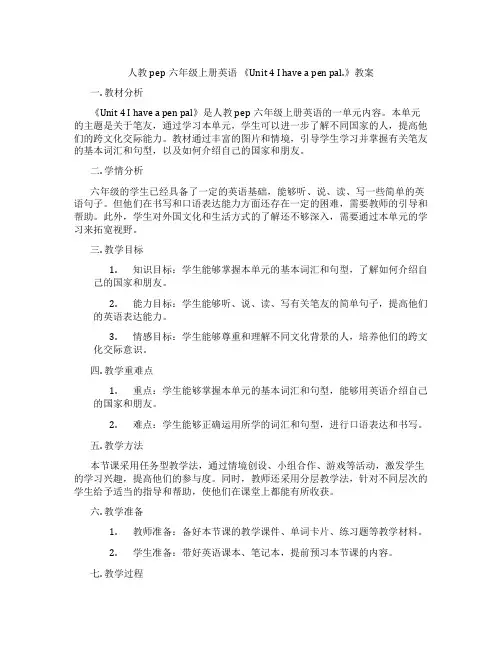
人教pep六年级上册英语《Unit 4 I have a pen pal.》教案一. 教材分析《Unit 4 I have a pen pal》是人教pep六年级上册英语的一单元内容。
本单元的主题是关于笔友,通过学习本单元,学生可以进一步了解不同国家的人,提高他们的跨文化交际能力。
教材通过丰富的图片和情境,引导学生学习并掌握有关笔友的基本词汇和句型,以及如何介绍自己的国家和朋友。
二. 学情分析六年级的学生已经具备了一定的英语基础,能够听、说、读、写一些简单的英语句子。
但他们在书写和口语表达能力方面还存在一定的困难,需要教师的引导和帮助。
此外,学生对外国文化和生活方式的了解还不够深入,需要通过本单元的学习来拓宽视野。
三. 教学目标1.知识目标:学生能够掌握本单元的基本词汇和句型,了解如何介绍自己的国家和朋友。
2.能力目标:学生能够听、说、读、写有关笔友的简单句子,提高他们的英语表达能力。
3.情感目标:学生能够尊重和理解不同文化背景的人,培养他们的跨文化交际意识。
四. 教学重难点1.重点:学生能够掌握本单元的基本词汇和句型,能够用英语介绍自己的国家和朋友。
2.难点:学生能够正确运用所学的词汇和句型,进行口语表达和书写。
五. 教学方法本节课采用任务型教学法,通过情境创设、小组合作、游戏等活动,激发学生的学习兴趣,提高他们的参与度。
同时,教师还采用分层教学法,针对不同层次的学生给予适当的指导和帮助,使他们在课堂上都能有所收获。
六. 教学准备1.教师准备:备好本节课的教学课件、单词卡片、练习题等教学材料。
2.学生准备:带好英语课本、笔记本,提前预习本节课的内容。
七. 教学过程1.导入(5分钟)教师通过向学生展示不同国家的图片,引导学生谈论各自喜欢的国家,从而引出本节课的主题——笔友。
2.呈现(10分钟)教师通过课件展示本节课的基本词汇和句型,让学生初步感知和理解。
3.操练(10分钟)教师学生进行口语练习,让学生在实际情境中运用所学的词汇和句型。
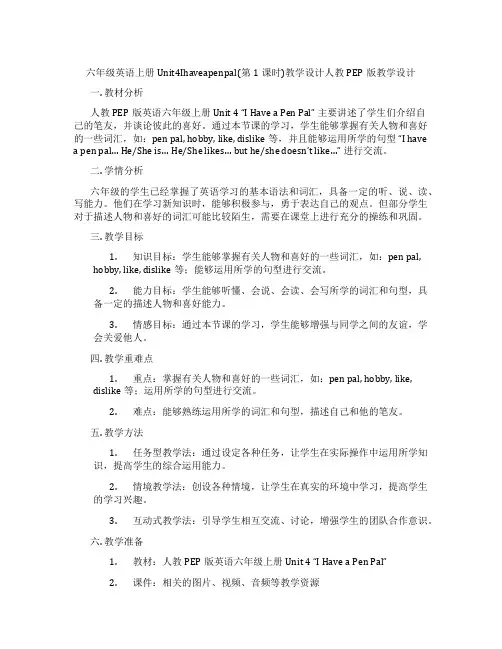
六年级英语上册Unit4Ihaveapenpal(第1课时)教学设计人教PEP版教学设计一. 教材分析人教PEP版英语六年级上册Unit 4 “I Have a Pen Pal” 主要讲述了学生们介绍自己的笔友,并谈论彼此的喜好。
通过本节课的学习,学生能够掌握有关人物和喜好的一些词汇,如:pen pal, hobby, like, dislike等,并且能够运用所学的句型“I havea pen pal… He/She is… He/She likes… but he/she doesn’t like…” 进行交流。
二. 学情分析六年级的学生已经掌握了英语学习的基本语法和词汇,具备一定的听、说、读、写能力。
他们在学习新知识时,能够积极参与,勇于表达自己的观点。
但部分学生对于描述人物和喜好的词汇可能比较陌生,需要在课堂上进行充分的操练和巩固。
三. 教学目标1.知识目标:学生能够掌握有关人物和喜好的一些词汇,如:pen pal,hobby, like, dislike等;能够运用所学的句型进行交流。
2.能力目标:学生能够听懂、会说、会读、会写所学的词汇和句型,具备一定的描述人物和喜好能力。
3.情感目标:通过本节课的学习,学生能够增强与同学之间的友谊,学会关爱他人。
四. 教学重难点1.重点:掌握有关人物和喜好的一些词汇,如:pen pal, hobby, like,dislike等;运用所学的句型进行交流。
2.难点:能够熟练运用所学的词汇和句型,描述自己和他的笔友。
五. 教学方法1.任务型教学法:通过设定各种任务,让学生在实际操作中运用所学知识,提高学生的综合运用能力。
2.情境教学法:创设各种情境,让学生在真实的环境中学习,提高学生的学习兴趣。
3.互动式教学法:引导学生相互交流、讨论,增强学生的团队合作意识。
六. 教学准备1.教材:人教PEP版英语六年级上册Unit 4 “I Have a Pen Pal”2.课件:相关的图片、视频、音频等教学资源3.学具:笔、纸、卡片等4.教学场地:教室七. 教学过程1.导入(5分钟)教师通过向学生展示一些图片,引导学生谈论自己的朋友,为新课的学习营造一个轻松愉快的学习氛围。
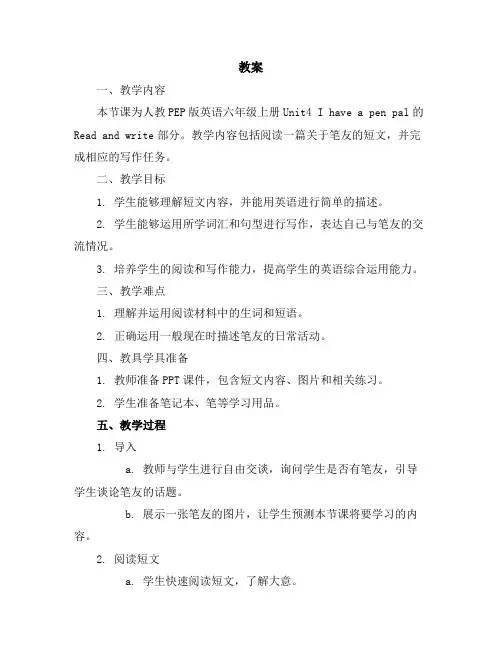
教案一、教学内容本节课为人教PEP版英语六年级上册Unit4 I have a pen pal的Read and write部分。
教学内容包括阅读一篇关于笔友的短文,并完成相应的写作任务。
二、教学目标1. 学生能够理解短文内容,并能用英语进行简单的描述。
2. 学生能够运用所学词汇和句型进行写作,表达自己与笔友的交流情况。
3. 培养学生的阅读和写作能力,提高学生的英语综合运用能力。
三、教学难点1. 理解并运用阅读材料中的生词和短语。
2. 正确运用一般现在时描述笔友的日常活动。
四、教具学具准备1. 教师准备PPT课件,包含短文内容、图片和相关练习。
2. 学生准备笔记本、笔等学习用品。
五、教学过程1. 导入a. 教师与学生进行自由交谈,询问学生是否有笔友,引导学生谈论笔友的话题。
b. 展示一张笔友的图片,让学生预测本节课将要学习的内容。
2. 阅读短文a. 学生快速阅读短文,了解大意。
b. 学生细读短文,完成相关练习,检测对短文内容的理解。
c. 教师针对短文中的生词和短语进行讲解,帮助学生理解。
3. 写作任务a. 教师给出写作任务,要求学生运用所学词汇和句型描述自己与笔友的交流情况。
b. 学生进行独立写作,教师巡回指导。
c. 学生完成写作后,进行同伴互评,互相修改作文。
a. 教师邀请几名学生分享自己的写作成果,给予肯定和鼓励。
六、板书设计板书设计如下:Unit4 I have a pen pal Read and write1. 阅读短文a. 理解短文内容b. 完成相关练习2. 写作任务a. 描述自己与笔友的交流情况b. 运用所学词汇和句型七、作业设计1. 完成课后练习,巩固所学知识。
2. 用英语写一篇关于自己笔友的短文,不少于50词。
八、课后反思本节课通过阅读和写作的方式,让学生了解并掌握了关于笔友的表达方式。
在阅读环节,学生通过快速阅读和细读,提高了阅读理解能力;在写作环节,学生运用所学词汇和句型进行写作,锻炼了写作能力。
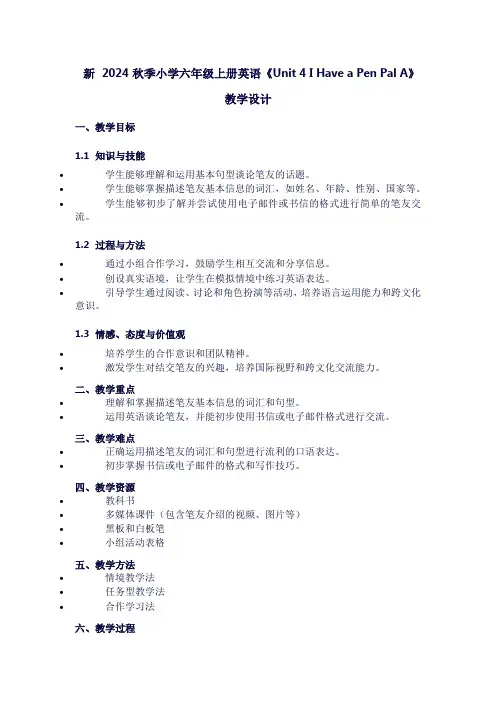
新2024秋季小学六年级上册英语《Unit 4 I Have a Pen Pal A》教学设计一、教学目标1.1 知识与技能•学生能够理解和运用基本句型谈论笔友的话题。
•学生能够掌握描述笔友基本信息的词汇,如姓名、年龄、性别、国家等。
•学生能够初步了解并尝试使用电子邮件或书信的格式进行简单的笔友交流。
1.2 过程与方法•通过小组合作学习,鼓励学生相互交流和分享信息。
•创设真实语境,让学生在模拟情境中练习英语表达。
•引导学生通过阅读、讨论和角色扮演等活动,培养语言运用能力和跨文化意识。
1.3 情感、态度与价值观•培养学生的合作意识和团队精神。
•激发学生对结交笔友的兴趣,培养国际视野和跨文化交流能力。
二、教学重点•理解和掌握描述笔友基本信息的词汇和句型。
•运用英语谈论笔友,并能初步使用书信或电子邮件格式进行交流。
三、教学难点•正确运用描述笔友的词汇和句型进行流利的口语表达。
•初步掌握书信或电子邮件的格式和写作技巧。
四、教学资源•教科书•多媒体课件(包含笔友介绍的视频、图片等)•黑板和白板笔•小组活动表格五、教学方法•情境教学法•任务型教学法•合作学习法六、教学过程1. 复习热身•通过快速问答复习上一单元学习的相关词汇和句型。
•引导学生谈论自己的朋友,为引入笔友话题做铺垫。
2. 新课呈现•导入新课:展示一段关于笔友交流的视频或图片,引起学生兴趣,并引出新课主题。
•呈现新课内容:使用多媒体课件展示课文,让学生跟读并理解课文内容。
•词汇和句型讲解:针对新词汇和句型进行重点讲解,并通过例句帮助学生理解。
3. 趣味操练•角色扮演:学生分组进行角色扮演,模拟结交笔友的场景,练习使用英语进行自我介绍和询问信息。
•词汇接龙:以小组为单位,围绕笔友主题进行词汇接龙游戏,巩固所学词汇。
4. 运用拓展•小组讨论:学生分组讨论并编写一段关于自己假想笔友的介绍,包括姓名、年龄、国家等基本信息。
•写作练习:指导学生写一封简单的电子邮件或书信给假想笔友,介绍自己的日常生活并询问对方的相关情况。
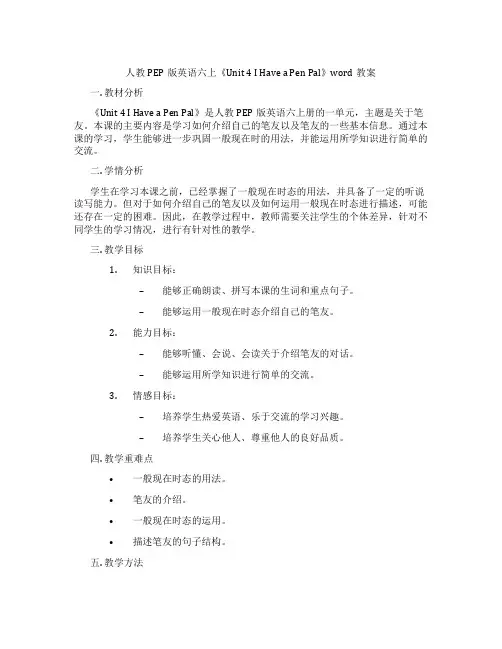
人教PEP版英语六上《Unit 4 I Have a Pen Pal》word教案一. 教材分析《Unit 4 I Have a Pen Pal》是人教PEP版英语六上册的一单元,主题是关于笔友。
本课的主要内容是学习如何介绍自己的笔友以及笔友的一些基本信息。
通过本课的学习,学生能够进一步巩固一般现在时的用法,并能运用所学知识进行简单的交流。
二. 学情分析学生在学习本课之前,已经掌握了一般现在时态的用法,并具备了一定的听说读写能力。
但对于如何介绍自己的笔友以及如何运用一般现在时态进行描述,可能还存在一定的困难。
因此,在教学过程中,教师需要关注学生的个体差异,针对不同学生的学习情况,进行有针对性的教学。
三. 教学目标1.知识目标:–能够正确朗读、拼写本课的生词和重点句子。
–能够运用一般现在时态介绍自己的笔友。
2.能力目标:–能够听懂、会说、会读关于介绍笔友的对话。
–能够运用所学知识进行简单的交流。
3.情感目标:–培养学生热爱英语、乐于交流的学习兴趣。
–培养学生关心他人、尊重他人的良好品质。
四. 教学重难点•一般现在时态的用法。
•笔友的介绍。
•一般现在时态的运用。
•描述笔友的句子结构。
五. 教学方法1.任务型教学法:通过完成各种任务,激发学生的学习兴趣,提高学生的学习积极性。
2.情境教学法:创设真实的语言环境,让学生在实际情境中学习、运用英语。
3.合作学习法:鼓励学生之间相互合作,提高学生的团队协作能力。
六. 教学准备1.教学材料:教材、多媒体课件、录音机、磁带。
2.教学工具:黑板、粉笔、挂图。
3.教学资源:网络、图书。
七. 教学过程1.导入(5分钟)教师通过提问方式,引导学生谈论自己的朋友,从而引入本课的主题——笔友。
2.呈现(5分钟)教师展示教材中的插图,引导学生看图说话,介绍图片中的人物和物品。
同时,教师呈现本课的生词和重点句子,让学生初步感知语言。
3.操练(10分钟)教师学生进行pr work,让学生相互介绍自己的笔友,并运用一般现在时态进行描述。
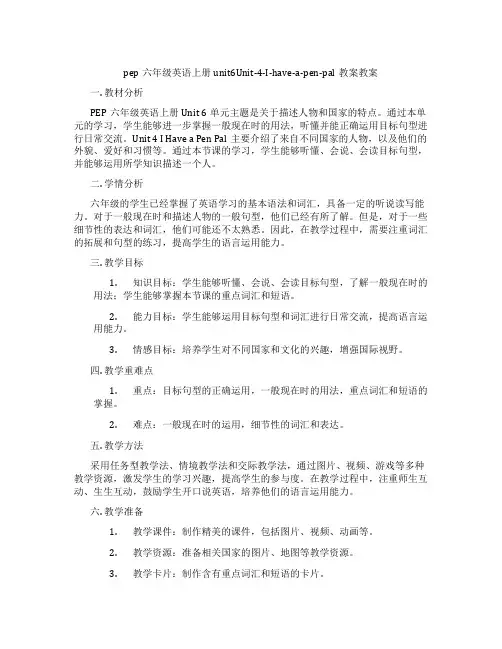
pep六年级英语上册unit6Unit-4-I-have-a-pen-pal教案教案一. 教材分析PEP六年级英语上册Unit 6单元主题是关于描述人物和国家的特点。
通过本单元的学习,学生能够进一步掌握一般现在时的用法,听懂并能正确运用目标句型进行日常交流。
Unit 4 I Have a Pen Pal主要介绍了来自不同国家的人物,以及他们的外貌、爱好和习惯等。
通过本节课的学习,学生能够听懂、会说、会读目标句型,并能够运用所学知识描述一个人。
二. 学情分析六年级的学生已经掌握了英语学习的基本语法和词汇,具备一定的听说读写能力。
对于一般现在时和描述人物的一般句型,他们已经有所了解。
但是,对于一些细节性的表达和词汇,他们可能还不太熟悉。
因此,在教学过程中,需要注重词汇的拓展和句型的练习,提高学生的语言运用能力。
三. 教学目标1.知识目标:学生能够听懂、会说、会读目标句型,了解一般现在时的用法;学生能够掌握本节课的重点词汇和短语。
2.能力目标:学生能够运用目标句型和词汇进行日常交流,提高语言运用能力。
3.情感目标:培养学生对不同国家和文化的兴趣,增强国际视野。
四. 教学重难点1.重点:目标句型的正确运用,一般现在时的用法,重点词汇和短语的掌握。
2.难点:一般现在时的运用,细节性的词汇和表达。
五. 教学方法采用任务型教学法、情境教学法和交际教学法,通过图片、视频、游戏等多种教学资源,激发学生的学习兴趣,提高学生的参与度。
在教学过程中,注重师生互动、生生互动,鼓励学生开口说英语,培养他们的语言运用能力。
六. 教学准备1.教学课件:制作精美的课件,包括图片、视频、动画等。
2.教学资源:准备相关国家的图片、地图等教学资源。
3.教学卡片:制作含有重点词汇和短语的卡片。
4.录音机、音响等设备:用于播放录音。
七. 教学过程1.导入(5分钟)通过播放一段关于不同国家的视频,引导学生谈论各自喜欢的国家,激发学生的学习兴趣。
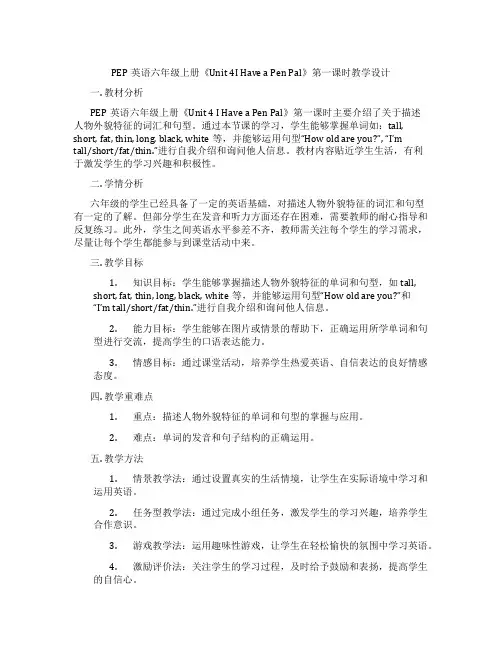
PEP英语六年级上册《Unit 4I Have a Pen Pal》第一课时教学设计一. 教材分析PEP英语六年级上册《Unit 4 I Have a Pen Pal》第一课时主要介绍了关于描述人物外貌特征的词汇和句型。
通过本节课的学习,学生能够掌握单词如:tall, short, fat, thin, long, black, white等,并能够运用句型“How old are you?”, “I’mtall/short/fat/thin.”进行自我介绍和询问他人信息。
教材内容贴近学生生活,有利于激发学生的学习兴趣和积极性。
二. 学情分析六年级的学生已经具备了一定的英语基础,对描述人物外貌特征的词汇和句型有一定的了解。
但部分学生在发音和听力方面还存在困难,需要教师的耐心指导和反复练习。
此外,学生之间英语水平参差不齐,教师需关注每个学生的学习需求,尽量让每个学生都能参与到课堂活动中来。
三. 教学目标1.知识目标:学生能够掌握描述人物外貌特征的单词和句型,如tall,short, fat, thin, long, black, white等,并能够运用句型“How old are you?”和“I’m tall/short/fat/thin.”进行自我介绍和询问他人信息。
2.能力目标:学生能够在图片或情景的帮助下,正确运用所学单词和句型进行交流,提高学生的口语表达能力。
3.情感目标:通过课堂活动,培养学生热爱英语、自信表达的良好情感态度。
四. 教学重难点1.重点:描述人物外貌特征的单词和句型的掌握与应用。
2.难点:单词的发音和句子结构的正确运用。
五. 教学方法1.情景教学法:通过设置真实的生活情境,让学生在实际语境中学习和运用英语。
2.任务型教学法:通过完成小组任务,激发学生的学习兴趣,培养学生合作意识。
3.游戏教学法:运用趣味性游戏,让学生在轻松愉快的氛围中学习英语。
4.激励评价法:关注学生的学习过程,及时给予鼓励和表扬,提高学生的自信心。
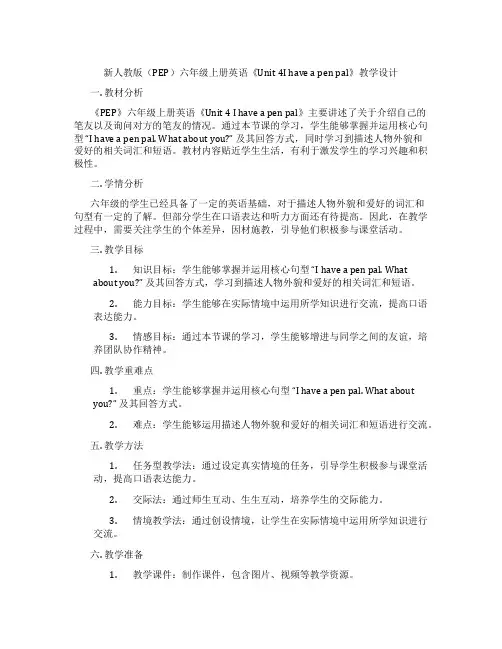
新人教版(PEP)六年级上册英语《Unit 4I have a pen pal》教学设计一. 教材分析《PEP》六年级上册英语《Unit 4 I have a pen pal》主要讲述了关于介绍自己的笔友以及询问对方的笔友的情况。
通过本节课的学习,学生能够掌握并运用核心句型“I have a pen pal. What about you?” 及其回答方式,同时学习到描述人物外貌和爱好的相关词汇和短语。
教材内容贴近学生生活,有利于激发学生的学习兴趣和积极性。
二. 学情分析六年级的学生已经具备了一定的英语基础,对于描述人物外貌和爱好的词汇和句型有一定的了解。
但部分学生在口语表达和听力方面还有待提高。
因此,在教学过程中,需要关注学生的个体差异,因材施教,引导他们积极参与课堂活动。
三. 教学目标1.知识目标:学生能够掌握并运用核心句型“I have a pen pal. Whatabout you?” 及其回答方式,学习到描述人物外貌和爱好的相关词汇和短语。
2.能力目标:学生能够在实际情境中运用所学知识进行交流,提高口语表达能力。
3.情感目标:通过本节课的学习,学生能够增进与同学之间的友谊,培养团队协作精神。
四. 教学重难点1.重点:学生能够掌握并运用核心句型“I have a pen pal. What aboutyou?” 及其回答方式。
2.难点:学生能够运用描述人物外貌和爱好的相关词汇和短语进行交流。
五. 教学方法1.任务型教学法:通过设定真实情境的任务,引导学生积极参与课堂活动,提高口语表达能力。
2.交际法:通过师生互动、生生互动,培养学生的交际能力。
3.情境教学法:通过创设情境,让学生在实际情境中运用所学知识进行交流。
六. 教学准备1.教学课件:制作课件,包含图片、视频等教学资源。
2.教学卡片:制作描述人物外貌和爱好的相关词汇和短语的卡片。
3.录音机、耳机等音响设备:用于播放听力材料。
4.笔和笔记本:用于学生记录课堂内容。
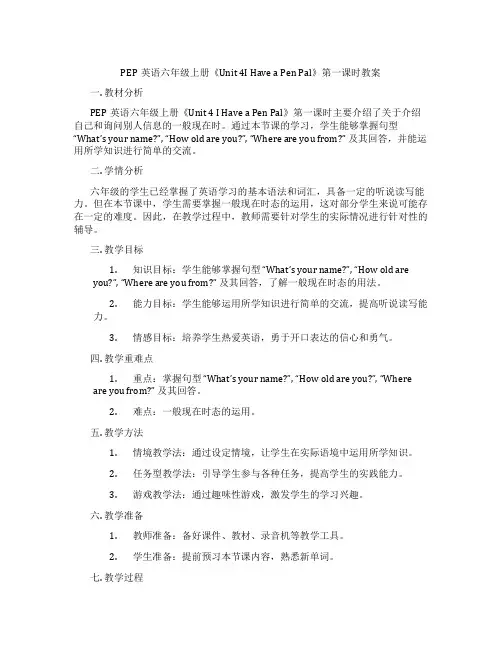
PEP英语六年级上册《Unit 4I Have a Pen Pal》第一课时教案一. 教材分析PEP英语六年级上册《Unit 4 I Have a Pen Pal》第一课时主要介绍了关于介绍自己和询问别人信息的一般现在时。
通过本节课的学习,学生能够掌握句型“What’s your name?”, “How old are you?”, “Where are you from?” 及其回答,并能运用所学知识进行简单的交流。
二. 学情分析六年级的学生已经掌握了英语学习的基本语法和词汇,具备一定的听说读写能力。
但在本节课中,学生需要掌握一般现在时态的运用,这对部分学生来说可能存在一定的难度。
因此,在教学过程中,教师需要针对学生的实际情况进行针对性的辅导。
三. 教学目标1.知识目标:学生能够掌握句型“What’s your name?”, “How old areyou?”, “Where are you from?” 及其回答,了解一般现在时态的用法。
2.能力目标:学生能够运用所学知识进行简单的交流,提高听说读写能力。
3.情感目标:培养学生热爱英语,勇于开口表达的信心和勇气。
四. 教学重难点1.重点:掌握句型“What’s your name?”, “How old are you?”, “Whereare you from?” 及其回答。
2.难点:一般现在时态的运用。
五. 教学方法1.情境教学法:通过设定情境,让学生在实际语境中运用所学知识。
2.任务型教学法:引导学生参与各种任务,提高学生的实践能力。
3.游戏教学法:通过趣味性游戏,激发学生的学习兴趣。
六. 教学准备1.教师准备:备好课件、教材、录音机等教学工具。
2.学生准备:提前预习本节课内容,熟悉新单词。
七. 教学过程1.导入(5分钟)教师通过播放音乐,引导学生跟着节奏唱英文歌曲,调动学生的学习氛围。
然后提问学生“What’s your name?”,让学生进行自我介绍,引出本节课的主题。
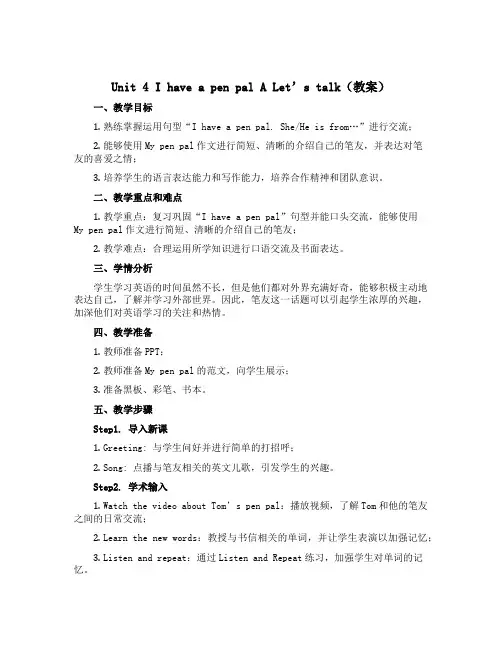
Unit 4 I have a pen pal A Let’s talk(教案)一、教学目标1.熟练掌握运用句型“I have a pen pal. She/He is from…”进行交流;2.能够使用My pen pal作文进行简短、清晰的介绍自己的笔友,并表达对笔友的喜爱之情;3.培养学生的语言表达能力和写作能力,培养合作精神和团队意识。
二、教学重点和难点1.教学重点:复习巩固“I have a pen pal”句型并能口头交流,能够使用My pen pal作文进行简短、清晰的介绍自己的笔友;2.教学难点:合理运用所学知识进行口语交流及书面表达。
三、学情分析学生学习英语的时间虽然不长,但是他们都对外界充满好奇,能够积极主动地表达自己,了解并学习外部世界。
因此,笔友这一话题可以引起学生浓厚的兴趣,加深他们对英语学习的关注和热情。
四、教学准备1.教师准备PPT;2.教师准备My pen pal的范文,向学生展示;3.准备黑板、彩笔、书本。
五、教学步骤Step1. 导入新课1.Greeting: 与学生问好并进行简单的打招呼;2.Song: 点播与笔友相关的英文儿歌,引发学生的兴趣。
Step2. 学术输入1.Watch the video about Tom’s pen pal:播放视频,了解Tom和他的笔友之间的日常交流;2.Learn the new words:教授与书信相关的单词,并让学生表演以加强记忆;3.Listen and repeat:通过Listen and Repeat练习,加强学生对单词的记忆。
Step3. 学科输出1.Follow the tape and chant together:带着学生一起朗读课文,并呈现课文的上下文信息;2.Pair work:学生以两人为一组,自由交换关于笔友的信息,运用所学语言表达情感;3.Group work:多人小组讨论并撰写My pen pal作文,并在班级中进行分享;4.Wrap-up: 教师对本堂课的内容进行复习和总结。
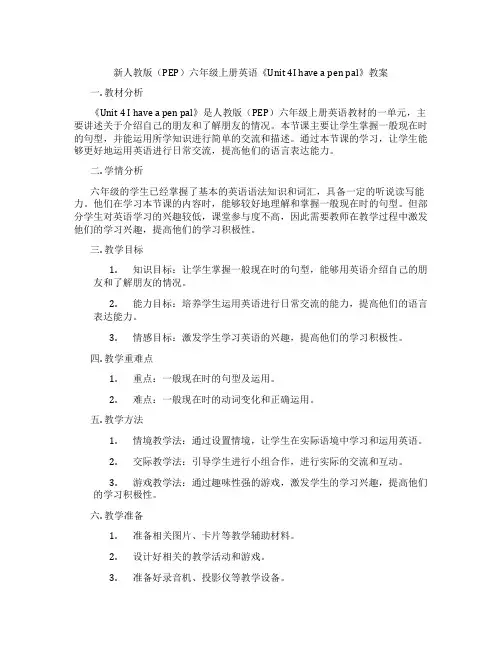
新人教版(PEP)六年级上册英语《Unit 4I have a pen pal》教案一. 教材分析《Unit 4 I have a pen pal》是人教版(PEP)六年级上册英语教材的一单元,主要讲述关于介绍自己的朋友和了解朋友的情况。
本节课主要让学生掌握一般现在时的句型,并能运用所学知识进行简单的交流和描述。
通过本节课的学习,让学生能够更好地运用英语进行日常交流,提高他们的语言表达能力。
二. 学情分析六年级的学生已经掌握了基本的英语语法知识和词汇,具备一定的听说读写能力。
他们在学习本节课的内容时,能够较好地理解和掌握一般现在时的句型。
但部分学生对英语学习的兴趣较低,课堂参与度不高,因此需要教师在教学过程中激发他们的学习兴趣,提高他们的学习积极性。
三. 教学目标1.知识目标:让学生掌握一般现在时的句型,能够用英语介绍自己的朋友和了解朋友的情况。
2.能力目标:培养学生运用英语进行日常交流的能力,提高他们的语言表达能力。
3.情感目标:激发学生学习英语的兴趣,提高他们的学习积极性。
四. 教学重难点1.重点:一般现在时的句型及运用。
2.难点:一般现在时的动词变化和正确运用。
五. 教学方法1.情境教学法:通过设置情境,让学生在实际语境中学习和运用英语。
2.交际教学法:引导学生进行小组合作,进行实际的交流和互动。
3.游戏教学法:通过趣味性强的游戏,激发学生的学习兴趣,提高他们的学习积极性。
六. 教学准备1.准备相关图片、卡片等教学辅助材料。
2.设计好相关的教学活动和游戏。
3.准备好录音机、投影仪等教学设备。
七. 教学过程1.导入(5分钟)利用图片和卡片,引导学生谈论自己的朋友,为新课的学习营造一个轻松愉快的氛围。
2.呈现(10分钟)展示教材中的插图,引导学生观察并回答问题。
例如:“Who is pen pal? What does he/she look like? What does he/she like to do?”等。
人教pep六年级上册英语《 Unit 4 I have a pen pal(A-Let’s talk)》教案一. 教材分析《Unit 4 I have a pen pal(A-Let’s talk)》是人教PEP六年级上册英语教材的一部分。
本节课主要介绍关于介绍朋友以及询问和回答朋友相关信息的内容。
通过本节课的学习,学生能够掌握核心句型“I have a pen pal. What’s his/her name?He/She is from…”以及能够运用一般现在时描述朋友的特征和喜好。
二. 学情分析六年级的学生已经掌握了基本的英语语法和词汇,具备一定的听说读写能力。
他们对学习英语有较高的兴趣,善于模仿和表演。
但在口语表达方面,部分学生可能会存在发音不准确、词汇量不足等问题。
因此,在教学过程中,教师需要关注学生的个体差异,充分调动学生的积极性,提高他们的口语表达能力。
三. 教学目标1.知识目标:学生能够掌握核心句型“I have a pen pal. What’s his/hername? He/She is from…”以及一般现在时描述朋友的特征和喜好。
2.能力目标:学生能够在真实情境中运用所学知识进行交流,提高口语表达能力。
3.情感目标:培养学生热爱交朋友,拓宽视野,提高跨文化交际意识。
四. 教学重难点1.重点:掌握核心句型“I have a pen pal. What’s his/her name? He/Sheis from…”以及运用一般现在时描述朋友的特征和喜好。
2.难点:一般现在时的运用,特别是在询问和回答朋友相关信息时。
五. 教学方法1.情境教学法:通过设定真实情境,让学生在实际交流中掌握所学知识。
2.任务型教学法:通过完成小组任务,促进学生之间的互动和合作。
3.游戏教学法:通过趣味性游戏,激发学生的学习兴趣,提高课堂活力。
4.交际性教学法:注重培养学生的交际能力,鼓励学生在课堂上积极发言。
人教版(PEP)六年级上册《Unit 4 I have a pen pal Part B》教案一. 教材分析人教版(PEP)六年级上册《Unit 4 I have a pen pal Part B》教材内容主要包括:听力、口语、阅读和写作四个部分。
本节课主要围绕“我有一个笔友”这一主题展开,通过学习,使学生能够熟练运用本课所学知识进行日常交流,提高他们的英语水平。
二. 学情分析六年级的学生已经具备了一定的英语基础,对于日常的英语交流和简单的人民群众生活常识有所了解。
但是,他们的英语听说能力仍需进一步提高,对于本节课的一些生词和短语可能会有难度,需要教师进行详细的讲解和辅导。
三. 教学目标1.知识目标:学生能够听懂、说出一封信的基本格式,学会如何介绍自己的朋友。
2.能力目标:学生能够通过听、说、读、写等多种方式,熟练运用本课所学知识进行交流。
3.情感目标:培养学生热爱交流,乐于交友的良好品质。
四. 教学重难点1.重点:信件的基本格式,如何介绍自己的朋友。
2.难点:一些生词和短语的运用,如“pen pal”,“have a great time”等。
五. 教学方法1.任务型教学法:通过设置各种任务,让学生在完成任务的过程中,自然地学习和掌握知识。
2.情境教学法:创设各种真实的交流情境,让学生在实践中提高英语水平。
3.游戏教学法:通过各种有趣的游戏,激发学生的学习兴趣,提高他们的学习积极性。
六. 教学准备1.教师准备:准备好本节课所需的课件、教材、录音机等教学工具。
2.学生准备:提前让学生预习本节课的内容,了解信件的基本格式。
七. 教学过程1.导入(5分钟)教师通过提问方式,引导学生谈论他们自己的朋友,从而引出本节课的主题“我有一个笔友”。
2.呈现(10分钟)教师通过课件展示本节课的主要内容,让学生初步了解信件的基本格式和如何介绍自己的朋友。
3.操练(10分钟)教师学生进行各种操练活动,如角色扮演、小组讨论等,让学生在实践中掌握本课所学知识。
人教PEP版英语六年级上册Unit 4《I have a pen pal》word单元教案一. 教材分析《人教PEP版英语六年级上册Unit 4 I have a pen pal》主要讲述关于笔友的话题。
本节课通过介绍不同国家的笔友,让学生学会介绍自己的国家和朋友,以及如何询问对方的国家的相关信息。
教材内容丰富,插图生动有趣,激发学生的学习兴趣。
本节课的主要语言知识点包括:一般现在时的肯定句和否定句,以及如何使用频度词。
二. 学情分析六年级的学生已经掌握了英语学习的基本语法和词汇,具备一定的听、说、读、写能力。
他们对于介绍自己和他人有一定的了解,但如何在笔友交流中运用所学的语言知识还需要进一步指导。
此外,学生对于不同国家的文化差异有一定的好奇心,这有助于激发他们的学习兴趣。
三. 教学目标1.知识目标:–学会介绍自己和朋友的信息,如姓名、年龄、国家、喜好等。
–掌握一般现在时的肯定句和否定句。
–学会使用频度词表达日常活动的习惯。
2.能力目标:–能够流利地用英语介绍自己和朋友。
–能够听懂并回应对方的介绍。
3.情感目标:–培养学生的跨文化交际意识,尊重不同国家的文化差异。
–增强学生学习英语的兴趣,提高他们的自信心。
四. 教学重难点•一般现在时的肯定句和否定句。
•频度词的使用。
•如何运用所学知识进行真实的笔友交流。
五. 教学方法1.任务型教学法:通过设定真实的学习任务,让学生在完成任务的过程中运用所学知识。
2.情境教学法:创设生动有趣的情境,让学生在实际语境中学习英语。
3.交际教学法:鼓励学生积极参与课堂交际活动,提高他们的实际运用能力。
六. 教学准备1.教学课件:制作生动有趣的课件,辅助教学。
2.教学素材:准备不同国家的图片、地图等,用于展示和介绍。
3.笔友卡片:制作笔友卡片,用于角色扮演和练习。
七. 教学过程1.导入(5分钟)–利用课件展示不同国家的图片,引导学生谈论各国特点。
–引入笔友话题,激发学生对笔友的兴趣。
人教pep六年级上册英语《Unit 4 I have a pen pal.》教学设计一. 教材分析《Unit 4 I have a pen pal》是人教PEP六年级上册英语教材的一个单元,主要讲述关于笔友的话题。
本单元通过介绍不同国家的笔友,让学生学会如何介绍自己的国家和朋友。
教材包括听、说、读、写等多种形式的练习,帮助学生掌握相关词汇和句型,提高他们的语言运用能力。
二. 学情分析六年级的学生已经具备一定的英语基础,能听懂简单的英语对话,并能进行简单的英语交流。
然而,他们在口语表达、听力理解以及写作方面还存在一定的困难。
因此,在教学过程中,教师需要关注学生的个体差异,合理安排教学内容,引导他们积极参与课堂活动,提高他们的英语水平。
三. 教学目标1.知识目标:让学生掌握有关国家、姓名、年龄、爱好等基本词汇;学会介绍自己的国家和朋友。
2.能力目标:培养学生具备听、说、读、写等方面的能力,能用英语简单介绍自己的国家和朋友。
3.情感目标:培养学生热爱祖国,尊重不同文化的态度,拓宽视野。
四. 教学重难点1.重点:掌握相关词汇和句型,能用英语介绍自己的国家和朋友。
2.难点:正确运用语法知识,进行简单的英语写作。
五. 教学方法1.情境教学法:通过创设情境,让学生在实际语境中学习、运用英语。
2.交际教学法:鼓励学生积极参与课堂互动,提高他们的口语表达能力。
3.任务型教学法:通过完成任务,让学生在实践中掌握所学知识。
六. 教学准备1.准备相关国家的图片、视频等教学资源。
2.准备教材、听力材料、练习题等教学用具。
3.提前让学生准备介绍自己国家和朋友的短文。
七. 教学过程1.导入(5分钟)利用图片、视频等资源,引导学生谈论不同国家的人,激发学生的学习兴趣。
2.呈现(10分钟)展示教材中的对话,让学生听懂并理解对话内容,引导学生关注对话中的国家和朋友介绍。
3.操练(10分钟)分组进行角色扮演,让学生模仿对话,进行实际操作。
六年级上册英语习题教案《Unit 4I have a pen pal》人教(PEP)教案一. 教材分析本单元主题是“I have a pen pal”,主要讲述了学生们通过书信交流,介绍自己的家庭成员、朋友以及喜好等。
通过本单元的学习,让学生能够掌握一些基本的交际用语,提高他们的英语听说读写能力。
二. 学情分析六年级的学生已经具备一定的英语基础,对于日常的交际用语有所了解。
但是,他们在书写英语句子和表达自己的喜好方面还存在一定的困难。
因此,在教学过程中,需要注重培养学生的语言运用能力和交际能力。
三. 教学目标1.能够正确听说读写“I have a pen pal”、“My pen pal is from…”等句子。
2.能够介绍自己的家庭成员、朋友以及喜好等。
3.提高学生的英语听说读写能力,培养他们的交际能力。
四. 教学重难点1.重点:掌握本单元的生词和句子,能够进行简单的交流。
2.难点:正确运用英语表达自己的喜好和家庭成员等信息。
五. 教学方法采用任务型教学法,通过情景模拟、小组讨论、角色扮演等方式,让学生在实际语境中运用英语,提高他们的语言运用能力。
六. 教学准备1.准备相关生词和句子的图片或卡片。
2.准备一份家庭成员和朋友的信息表。
3.准备一些有关喜好的问题和答案。
七. 教学过程1.导入(5分钟)利用图片或卡片,引导学生复习与家庭成员和朋友相关的词汇,如“father, mother, brother, sister, friend”等。
同时,引导学生用英语介绍自己的家庭成员和朋友。
2.呈现(10分钟)向学生展示一份家庭成员和朋友的信息表,让学生根据表格内容,用英语进行介绍。
同时,引导学生注意表格中的关键词,如“pen pal, from, like”等。
3.操练(10分钟)将学生分成小组,让他们根据信息表,进行角色扮演,模拟实际场景,用英语介绍自己的家庭成员和朋友。
教师巡回指导,纠正学生的错误,并给予鼓励。
pep六年级英语上册unit6Unit-4-I-have-a-pen-pal教学设计教学设计一. 教材分析本单元的主题是“I have a pen pal”,主要让学生学会介绍自己的笔友,并能够通过信件交流。
通过本单元的学习,学生能够掌握相关的词汇和句型,如“I have a pen pal in…”,“His/Her name is…”等,并能够运用所学知识进行简单的笔友交流。
二. 学情分析学生在学习本单元前,已经掌握了基本的英语语法和词汇,具备一定的听说读写能力。
但是,对于书写正式的书信可能还比较陌生,因此需要在教学中进行一定的指导和练习。
三. 教学目标1.能够正确地介绍自己的笔友,并能够用英语书写简单的信件。
2.能够听懂并能够运用本单元的重点词汇和句型进行交流。
3.能够通过本单元的学习,增强对于英语书信文化的了解和认识。
四. 教学重难点1.重点:掌握介绍笔友的词汇和句型,能够书写简单的英语书信。
2.难点:正确书写英语书信的基本格式和礼貌用语。
五. 教学方法采用任务型教学法,通过设定各种真实的情境,让学生在实践中学习和掌握知识。
同时,采用分组合作学习的方式,让学生在小组内进行互动交流,提高学生的口语表达能力和团队合作能力。
六. 教学准备1.准备一些有关笔友的图片和资料,用于导入和呈现环节。
2.准备一些信件模板,用于书写练习环节。
3.准备一些有关笔友的听力材料,用于听力训练环节。
七. 教学过程1.导入(5分钟)通过展示一些有关笔友的图片和资料,引导学生思考什么是笔友,并激发学生学习本单元的兴趣。
2.呈现(10分钟)通过展示一些笔友的信件,引导学生学习本单元的重点词汇和句型,如“I havea pen pal in…”,“His/Her name is…”等。
3.操练(10分钟)让学生分成小组,互相扮演笔友,进行对话练习。
教师巡回指导,纠正学生的错误,并给予鼓励。
4.巩固(10分钟)让学生独立完成一份关于自己笔友的介绍,并展示给其他同学。
Unit 4 I have a pen pal第一课时教学目标:1.能够听、说、读、写与爱好有关的英文表达。
2.能够听说认读的单词和词组pen pal, hobby, jasmine, idea等。
3.能够听懂,会说,会表演main scene和Let’s talk的内容,并在真实情境中运用所学语言询问和描述他人的兴趣和爱好。
教学重难点:重点:1.能够在实际语境中运用有关兴趣和爱好的问答句.What are…hobbies?He\She likes…交流.2.能够表演并内化Main scene 和Let’s talk 的交际内容.难点:学生能够大胆创编和表演询问和描述他人兴趣,爱好的小对话.教学过程:Step1 Warming-up幻灯片出示本课main scene中关于Zoom和Zip的教学挂图,教师询问Who are they? What are they doing? What are they talking about?学生先在小组内读一遍,再展开合理的想象,集体讨论后回答老师的问题。
Step2 Presentation1.学习重点句型What are ……hobbies?及其第三人称主语的回答He/She likes……(1)T: Every body has different hobbies, and I also have many hobbies.在幻灯片上出示教师游泳的图片,询问What am I doing?T: What am I doing? S: You are swimming. T: Yes, I am swimming.幻灯片出示I am swimming和I like swimming.两句,并用红色标注出两句不同的地方,通过颜色的对比,加强识记。
(2)What are you hobbies?教师随机询问几个学生,两人进行操练,教师选2-3组进行展示,在最后一组表演后,指着其中一个同学说:what are his hobbies?其回答He/She likes ……。
(3)教师出示句型What are his/her hobbies?及图片,学生两人一组操练小对话,之后选择2-3组进行展示。
2.Main scene学习(1)My friend Zhang Peng also likes making pen pal. He has a pen pal. Let’s know more about his pen pal, ok?播放对话,学生听录音或看视频并回答老师的提问“Who is Peter?Where does Peter come from?(2)环球链接:教师带领学生领略新西兰的人文地理,并介绍南北二岛(the North Island and the South Island.)(3)分角色朗读,男女对话,师生对话。
3.学习Let’s try& Let’s talk(1)学生审题后,教师播放Let’s try中的录音,后教师纠正答案。
(2)看Let’s talk的课文插图,听录音,理解意思,并回答教师的问题。
This is a dialogue between ZhangPeng and Oliver, what are they talkingabout?They are talking about Peter’s ho bbies.(3)听录音1-2遍,完成探究学习中第二题和第三题,并说出Peter 都有哪些爱好。
T: What are Peter’s hobbies?S:He likes reading stories, doing kung fu, swimming and singing.(4)教师提问细节性问题。
Where does Peter live?Why does Oliver say “Good idea!”Do you think Peter will like the Chinese song<Jasmine Flower>(5)根据课文内容,完成探究学习中第四题。
(6)小组内分角色朗读Let’s talk部分的课文,培养合作意识.(7)选2-3组进行课文表演展示,以检查学生对本课活动的掌握情况,教师评价,生生互评。
Step 3 Consolidation Do a survey& Make a dialogue.(1)学生3-4人一组,完成最好的朋友的兴趣、爱好调查(探究学习第五题),并参考课文内容,创编一个对话。
S1:Who is you r best friend?S2:Harry is my best friend.S1:Where does he live?S2:He lives in England.S1:What are his hobbies?S2:He likes dancing and playing basketball. What about you?S1:My best friend is Lily. She likes reading books, drawing pictures and traveling.S2:Wonderful!I also like traveling……(2)学生根据实际情况创编一个综合小对话,表演过程中拿出自己好朋友的照片绘神绘色地介绍。
(3)教师评价,生生互评。
学习谚语:A friend in need is a friend indeed.(4)思考:What kind of friends can be called ”good friend”?学生发表意见,教师引导出谚语A friend in need is a friend indeed.Step4 Homework1. 听录音,并背诵对话。
2.Finish the relevant workbook exercises.完成课堂检测中的相关习题。
3.告诉父母有关你朋友爱好的事情。
What are his\her hobbies?He\She likes…教学反思:第二课时教学目标1.正确掌握单词,词组:dancing , singing, reading stories, playing football等并进行现在分词的变化规律总结。
2.能够运用有关兴趣,爱好的英文表达what are your hobbies?和I like……进行回答。
3.能够听懂,会说Let’s learn的内容,并能根据实际情况运用本课重点句型表达自己的兴趣和爱好。
4.在对话交流中使学生养成用英语交流的习惯,培养良好的语音,语调和和语感。
教学重难点:重点:1.能够正确掌握单词,词组dancing, singing, reading stories, playing football, doing kungfu,并进行现在分词的基本变化规律总结.2.能够运用关兴趣,爱好的英文表达What are your hobbies?和I like…进行问答.难点:学生能够大胆创编和表演有关兴趣,爱好的小对话.教学过程:Step1 Warming-up &revision1.Greeting2.Let’s sing a song.播放本单元歌曲《my new pen pal》,学生在教师的引导下跟唱。
3.随着愉悦的音乐,教师告诉大家我们要开一个主题是hobby的class meeting,同学们要想参加必须成功“闯三关”。
Step2 Presentation1.Challenge1: Guessing Time.(1)展示本部分的图片,My new pen pal的音频片段,让学生猜。
T:What are my hobbies?S:You like singing.认读sing及其音标,告诉学生-ing的音标,并领读singing,学生随着教师重复I like singing,并用红色标注I like。
(2)呈现dancing:播放一段芭蕾舞视频片段,让学生猜。
用同样的方法学习dance,dancing,I like dancing,并以组为单位朗读。
(3)呈现reading stories:教师拿出一个盒子,让学生上前摸摸里面的物品。
T:What’s in the box?Can you guess?S:A book.打开盒子,里面有一本故事书,学生恍然大悟。
S: You like reading stories.学习Play football,playing football,I like playing football.自编chant操练。
(4)呈现幻灯片复习句型,Play a game:出示一棵苹果树的图片,学生说出掉落的苹果中所示的词组。
There are many phrases in the apple tree.Can you say out the phrases as quickly as you can?2. Challenge2:Sum-up Time(1)小组内朗读并讨论总结动词原形变现在分词的规律,完成探究学习中第一、二题。
(2)学生代表陈述总结,教师补充完善:动词直接加-ing;以不发音的字母e 结尾,去e加-ing;重读闭音节,以辅音字母结尾,再加-ing。
3.Challenge3:Dialogue Time.(1)学习PartA的Let’s l earn 部分。
看教学挂图,回答问题Who are they?听录音并完成探究学习中第三题。
(2)听录音,分角色朗读课文,让2-3组学生进行对话展示,师生共同评价。
(3)Make a dialogue:幻灯片呈现重点句型,学生造句练习及对话。
(4)play a game:listen to the music and pass the box.要求音乐停止时,其他同学一起拍手问What are your hobbies?手拿盒子的同学从盒子中抽出一张纸,根据内容回答。
Step 3 Consolidation闯关成功,开始班会(1)学生4人一组完成探究学习中第四题,并根据重点句型编写一个对话(2)学生自愿上前进行展演,师生共同评价。
Step4 Homework1.背诵所学重点单词和短语。
2.完成课堂检测中的相关习题。
3.告诉父母你兴趣爱好方面的事情。
板书设计:singingreading storiesWhat are your hobbies? I likes… playing footballDoing kung fu教学反思:第三课时教学目标1.能够听说朗读与爱好有关的英文表达,如Does he like doing word puzzles and going hiking? Yes, he does.2.能够正确听说认读单词amazing, Canberra等。